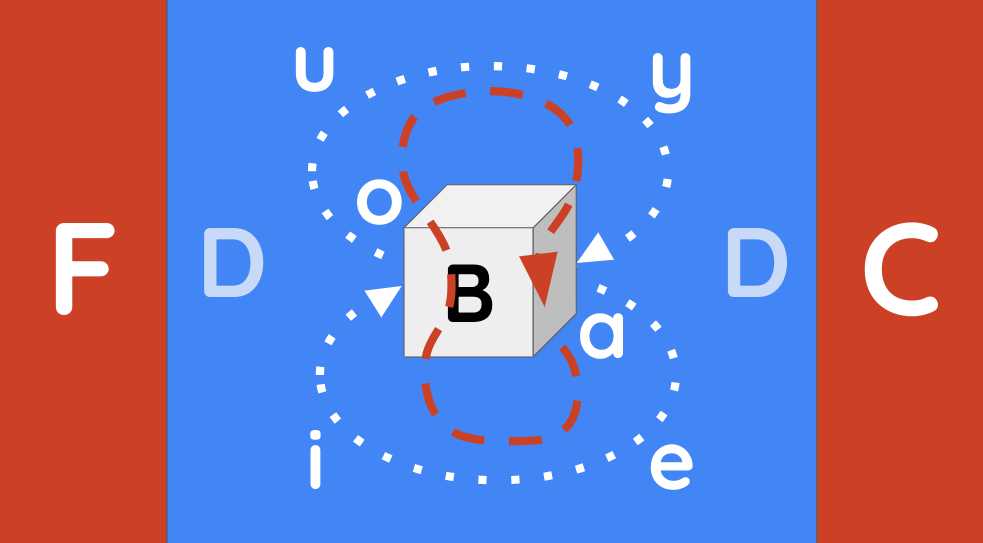The Contact Force of Solids and Fluids
Table of Contents
56. The particles of fluids are moved with equal force towards all particles
A hard body existing in a fluid can be determined to move by the smallest force.
We do not perceive the particles of fluids moving because they are too small.
- But their movement is easily inferred from their effects, especially in air and water, due to the fact that many other bodies disturb them.
This is because no bodily action, such as this corruption, can occur without local [relational] motion.
The causes of their motion will be discussed below.
Fluid particles do not move in one direction all at the same time.
This uniform movement would be necessary to allow the motion of bodies coming from any direction, as we see that they do not hinder it.
For example, the solid body B moves towards C.
- Particles of the intermediate fluid
Dare carried in the opposite direction fromCtowardsB. - These will not aid its motion but will rather hinder it more than if they were completely at rest.

To resolve this difficulty, it must be remembered that:
- rest is contrary to motion, not motion
- the direction of motion towards one part is contrary to the direction of motion towards the opposite part
- everything that moves always tends to continue in a straight line
So while the solid body B is at rest, the opposition of the particles of the fluid body D is greater against it than it were if it were moving.
There are as many particles of D moving from C towards B as there are moving from B towards C.
- They are the same particles that, coming from
C, impinge on the surface of bodyB, and then are turned back towardsC.
Each of these, considered separately, pushes B towards F upon striking it.
- Thus, the water impedes
Bfrom moving towardsCas if the water was at rest.
However, just as many water particles tend from F towards B and push it towards C.
- This is why
Bis not pushed more towards one side than the other.
Therefore, unless something else intervenes, B remains immobile.
Whatever shape B has, it will always be accurately pushed towards one side by as many particles of the fluid, but not towards the others.
We must assume that B is surrounded on all sides by the fluid DF.
If the quantity of this fluid is not as great in F as in D, it does not matter. This is because it does not act on B as a whole, but only on those parts of it that touch its surface.
So far, we have considered B as immobile.
Now we assume that it is pushed towards C by some force:
- to combine it with the particles of the fluid
DF - to direct them to push towards
C - to communicate to it a part of their motion
57. Demonstration of the same thing.
The hard body B is not yet in the fluid FD.
But the particles of this fluid are arranged in a ring-like fashion, moving circularly according to the order of the noted AEIOU and likewise for OUY.
For a body to be fluid, its particles must move in multiple ways, as previously mentioned.
Now, let the hard body B rest in this fluid FD between A and O. What will happen?

The AEIO particles will be prevented from passing from O to A to complete the circle of their motion.
Similarly, the OUYA particles will be prevented from going from A to O.
- Those coming from
ItowardsOwill pushBtowardsC. - Those coming from
YtowardsAwill push it equally towardsF.
Hence, they alone will not have the force to move it.
But they will be reflected:
- from
OtoU - from
AtoE.
This will result in one circulation from the two, following the order of the noted AEIOUYA.
And so, due to the encounter with body B, their motion will not be halted in any way.
Only the determination will change. They will not proceed in lines as straight or as close to straight as if they did not collide with B.
Assume some new force pushes B towards C.
It will combine with the force from the fluid particles coming from I towards O to push B towards C.
- This will overcome the force from
YtowardsAwhich pushedBtowardsF.
Therefore, it will suffice to change their determination and make them move according to the order of AEIOUYA, as required to not hinder the motion of body B.
What I say here about the AEIOUY particles also applies to all the other particles of the fluid FD that collide with B.
Each of them, among those pushing it towards C, is opposed by an equal number of others pushing it in the opposite direction.
- The very small force added to them is enough to change their determination.
They might not draw such circles as represented here by AEIO and OUY.
- But they all move circularly and in some ways equivalent to this.